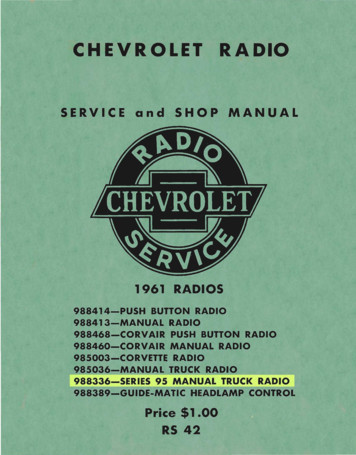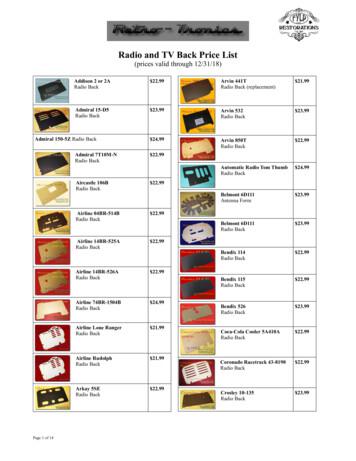An Introduction To Radio Astronomy And Meteor Forward .
An Introduction to Radio Astronomy andMeteor forward scatterWith Gnu Radio and SDRMarcus LeechVE3MDLImage appears courtesy NRAO/AUI
What is Radio Astronomy?Astronomy at wavelengths from a few mm to tensof meters Visible light has wavelengths in the region of500nm, that is, 5.0x10-7 meters From a physics standpoint, there's no differencebetween visible light, and microwave/radio-wave“light”. Living things have receptors for only a tiny part ofthe EM spectrum
Optical vs Radio AstronomyAbility to resolve fine detail highly dependent onwavelength A 10cm optical telescope can resolve details thatwould require a radio telescope over 42km indiameter at 21cm wavelength! Sensitivity, however, is proportional to collectingarea of the reflector, regardless of wavelength Both use parabolic reflectorsBoth must have a surface that is within 1/10th of awavelength of a “perfect” parabola.
The Electromagnetic spectrum
History of Radio AstronomyLike much in science, it was discoveredaccidentally Karl Jansky, 1933, working on sources of static oninternational radio-telephone circuits atwavelengths of 10-20m. Discovered that static rose and fell with a period of23 hours, 56 minutes. Must be of celestial origin
History, continuedBuilt directional antenna Pinpointed source at galactic centre, in Sagittarius
The Genesis of Radio AstronomyScienceJansky was re-assigned to other projects after hiswork on radio-telephone “hiss”. Several years went by with nobody understandingthe significance of his discovery Grote Reber picked up on Janskys work in 1937,building a 30ft dish in his back yard. Eventually mapped entire Milky Way emission at160MHz (1.8m wavelength)Published in Astrophysical Journal in 1944Radio Astronomy now taken seriously
Grote Rebers Dish Now preserved ashistorical artefact atNRAO, Green Bank,West Virginia
Rebers observations160 and 480MHzSkymap Made by hand fromdozens of chartrecordings
Radio Astronomy Today Radio Astronomy at the cutting-edge ofastrophysical research Big projects all over the world Roughly 70% of what we know today about the universeand its dynamics is due to radio astronomy observations,rather than optical observationsVLA, New MexicoArecibo, Puerto RicoGBT, Green Bank, West VirginiaWesterbork, Jodrell Bank, ALMA, Hat Creek, SKA, etcScientists named the basic flux unit after Karl Jansky 1 Jansky 10-26 watts/hz/meter2
How does the cosmos broadcast? Multiple mechanisms for emissions Blackbody radiationSynchrotron radiationSpectral lines from molecular and atomic gas clouds Pulsar emissionsMaser emissions Universe is more of a chemical “soup” than you'd guess fromoptical observations alone. RA lets you “see” the invisible.Special case of molecular line emissionsCosmic Microwave Background
Blackbody radiationAll objects that arewarmer than 0K emitEM radiation over awide spectrum Warmer objects havehigher peaks, at higherfrequencies (shorterwavelengths)
Synchrotron radiationCharged particles (e.g. electrons) acceleratingthrough a magnetic field Intensity higher at lower frequencies Above 1GHz, synchrotron radiation very weak
Spectral Line EmissionsMany atomic and molecular species undergoemissions due to quantum phenomenon Emission is spectrally pure: emitted at discretefrequencies, rather than a range of frequencies Lots of really big gas clouds in interstellar space,and in star-forming regions within galaxies
The 21cm hydrogen line Confirmed weeks later by team in Netherlands headed by JanVan Oort.Emission at 21.11cmwavelength(1420.40575MHz).Van De Hulst proposedexistence of neutralhydrogen in interstellarspace in 1944.Successfully detected in1951 by Ewen and Purcell atHarvard, using very modestinstrument
21cm line continued Density of interstellar hydrogen very low Less than 1 atom per cc of interstellar space!Emission caused by collisional energy transfer,causing electron spin change in neutral hydrogen A photon gets emitted at 21.11cm For a given atom, “perfect” collision only happensabout once every 100,000 to 1,000,000 years! But along any given line of sight, there's astaggering amount of neutral hydrogen
21cm emission phenomenonDoesn't happen tomolecular hydrogen Ionized hydrogen gasemits so-calledHydrogen-Alpha,which is visible light
Spectral lines and doppler effectExistence of spectral emissions allows science tomap velocities of gas clouds within and outside thegalaxy Doppler shift changes the observedwavelength/frequency of emission. Just like approaching/receding train whistle You can compute relative velocity by using theshifted wavelength and comparing to the “at rest”wavelength. EXTREMELY IMPORTANT RESULT
Pulsar emissionsUnderlying physics not well understood It is known that pulsar emissions originate fromrapidly rotating neutron stars Emissions arise from two or more “beams” alignedwith intense magnetic field of neutron star First discovered by Jocelyn Bell-Burnell in 1967 First thought to be “Little Green Men” Her PhD supervisor, Anthony Hewish, later wonthe nobel prize for this outstanding discovery. Many feel Jocelyn should have won the prize!
Pulsar emissions, contdPulse rates from once every 5 seconds, to severalhundred pulses per second—very short pulses Over 2000 pulsars have been catalogued Rapidly-rotating pulsars allow us to study the deepmechanisms of gravitation Many pulsars are very, very accurate clocks Better than the best atomic clocks humans can makeMassive angular momentum means that those pulseswill be arriving at nearly the same rate thousands ofyears from now!
Cosmic Microwave Background Theorized by George Gamow, in 1948 Would have to be present if Big Bang theory correctPenzias and Wilson at Bell Laboratoriesdiscovered it while calibrating sensitive satellitecommunications experiment in 1965. Found 2.7K excess system noise--why? Received Nobel Prize in Physics for this work in 1978In 2006, George Smoot received Nobel Prize formapping the so-called anisotropy (tiny variations)in the CMB, using a satellite to produce map.
Solar system objects Sun Moon Very strong microwave emitterMakes daytime observing of weaker objects impossibleUpper solar atmosphere strong black-body emitterBlack-body radiation with surface temperature around200KNOT reflection of solar microwave radiation!Jupiter/Io Io plasma torus interacts with Jupiters magnetic field Synchrotron emission peaked at 20-30MHz
SETI observing Some amateur RA observers also engage inamateur SETI research Looking for extremely-narrow “signals” near thehydrogen line frequency On the hairy edge of theoretical possibility ET civilization within 100ly with 300-400M dish couldproduce signal strong enough for detection withamateur-sized dish (3.8m approx) Could get “lucky”
Radio Astronomy Instruments Parabolic reflector Focal-plane antenna at focus of reflector From a few meters to over 300m!WaveguideDipoleVariousOne or more Low Noise Amplifiers Professional instruments chill the amplifiers in liquidHelium to reduce inherent electronic noiseAmateurs don't (usually) have that option Use the best amplifiers they can afford Sometimes chill with dry ice
Radio Astronomy instruments Receiver chain SpectralTotal-powerPulsarBack-end data processing Pulsar processing can require enormous computerpowerTotal-power and spectral can require large amounts ofstorage space
Imaging with multiple dishes Using multiple dishes, actual images can beformed using interferometry, and image synthesisImage courtesy NRAO/AUI This image was made with 27 dishes at the VLA, in New Mexico Cygnus A is 760Million light years away, with its featuresstretching over 400,000 light years
New RA science Many “big science” RA projects underway SKA Square Kilometer Array Goal is to build a multi-dish telescope with an effectivecollecting area of 1km2 or more! ALMA Atacama Large Millimeter Array 80 dish array, movable dishes Located 5km up on the Atacama plain, Chile Allows observing millimeter and submillimeter wavelengthsNew CMB satellites: WMAP, PLANCK More detailed maps of the CMB anisotropy
An amateur RA observatory Here's my (very modest!) dish.and my not so modest one
Meridian Transit Dish Arrangement Easiest for amateur to use Dish is aligned on the north-south meridian Use the pole star (polaris) as a guide for alignment Driven in elevation only Wait for earths rotation to bring objects into viewThe original 300ft dish at Green Bank was a meridian-transitsetup
SDR-based receiver for amateurs System I currently use
Processing signals Complex digitized signal: 'I' component (real) 'Q' component (imaginary) Total power: T.P. average (I2 Q2)Spectrum: average(FFT (I,Q))
Simple averaging using IIR filter Let be the averaging factor Chosen to produce the best “smoothing” Let S be the current sample Let X be the previous output value Then: X (S * ) ((1- ) * X)
simple ra: flow Graph in GRC
Gnu Radio software
Gnu Radio software
Amateur RA observations Typically single-dish instrument Total-power observationsSpectral observationsStability issues due to tiny amplification changescaused by temperature cyclingSome use two-element fixed interferometer Higher spatial resolution than single dishCan't do image synthesisMuch more stable than single-dish—gain changesfactored out due to mathematics of correlationHigher cost
Typical Total-Power observation Cygnus and Perseus/Auriga regions in total power
Typical Spectral Observations HI (Neutral hydrogen) spectrum near Cygnus A
Amateur Observations ContinuedWith patience, can do quite sophisticated projects Total-power mapping of galaxy, for example
Meteor Forward Scatter Use remote VHF stations to detect meteor inflow Pick a TX that’s below the radio horizon Broadcast FM, and VHF NTSC stations popular Fewer (almost none!) VHF NTSC stations left Might be able to use pilot tone of ATSC FM in many markets is saturated—there are no emptychannels
Meteor Forward Scatter
meteor detector Gnu Radio app
meteor detector Gnu Radio app
meteor detector Gnu Radio app
meteor detector Gnu Radio app
meteor detector Gnu Radio app
Closing remarksFewer students are entering post-secondaryastronomy programs Even fewer are pursuing careers in radio astronomy The existing scientists in RA are getting old :-) If science is your “thing”, consider astronomy
Further reading: Science Society of Amateur Radio Astronomers “Radio Astronomy Projects, 3rd ed”, William Lonc comNational Radio Astronomy Observatory http://www.nrao.edu http://www.cv.nrao.edu/course/astr534/ERA.shtml
Further reading: Tools Gnu Radio Ettus SDR radios See http://www.ettus.comRTL-SDR radios http:www/gnuradio.orgSee http://www.rtlsdr.orgsimple ra See https://www.cgran.org/svn/projects/simple ra
Radio Astronomy Today Radio Astronomy at the cutting-edge of astrophysical research Roughly 70% of what we know today about the universe and its dynamics is due to radio astronomy observations, rather than optical observations Big projects all over the world VLA, New Mexico Arecibo, Puerto Rico GBT, Green Bank, West Virginia Westerbork, Jodrell
Software-Defined Radio (SDR) Software Open source: GNU Radio, Liquid-DSP*, REDHAWK*, srsLTE** Commercial eNodeB and UE software (Amarisoft) . Radio Astronomy Research Driven by CASPER Radio astronomy Collaboration for Astronomy Signal Processing and Electronics Research .
SERVICE and SHOP MANUAL 1961 RADIOS 988414-PUSH BUTTON RADIO 988413-MANUAL RADIO 988468-CORVAIR PUSH BUTTON RADIO 988460-CORVAIR MANUAL RADIO 985003-CORVETTE RADIO 985036-MANUAL TRUCK RADIO 988336-SERIES 95 MANUAL TRUCK RADIO 988389-GUIDE-MATIC HEADLAMP CONTROL Price 1.00 . 89 switch and must be opened by speaker plug when testing radio.
Wavestown Answer Key Radio Waves Ray’s TV - TV reception uses radio waves Satellite Dish on top Ray’s - receives movies via radio waves from a satellite Taxi - Car radio reception uses radio signals Taxi - Driver receives instructions on a CB radio which uses radio waves Radio Tower - broadcast’s radio signals
Radio and TV Back Price List (prices valid through 12/31/18) Addison 2 or 2A Radio Back 22.99 Admiral 15-D5 Radio Back 23.99 Admiral 150-5Z Radio Back 24.99 Admiral 7T10M-N Radio Back 22.99 Aircastle 106B Radio Back 22.99 Airline 04BR-514B Radio Back 22.99 Airline 14BR-525A Radio Ba
Publishing is a powerful tool for amateur radio astronomy. 2. Spectroscope, v 2.9.0 This software allows you to view signals from special frequency-sweeping receivers at the Windward Community College Radio Observatory (WCCRO) and the University of Florida Radio Observatory (UFRO) and from many volunteer radio astronomers. These receivers, called
The goal of this session is to demonstrate the power of GPUs in real-time signal processing applications in radio astronomy telescopes, and outline the future growth path for this exciting new application of GPUs. Modern radio astronomy telescopes are mul\ tiple antenna instruments where the wideband data from each antenna needs to be processed .
Astronomy Level 2 Preview Try it before you buy it! This file contains a PDF preview of RSO Astronomy 2: Introduction and TOC Chapter 1 - Introduction to Astronomy Chapter 2 - The Big Bang We recommend using the latest Adobe Reader or Adobe Acrobat version
The Queen’s Awards for Enterprise are the UK’s most prestigious business awards, given only to companies or individuals who are outstanding in their field. Now in their 50th year, 2016 sees a high water mark of a total of 254 awards being presented: 150 for International Trade, 92 for Innovation, 7 for Sustainable Development and























